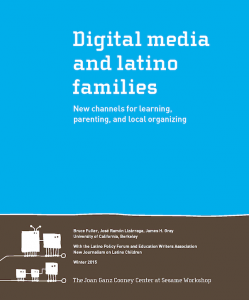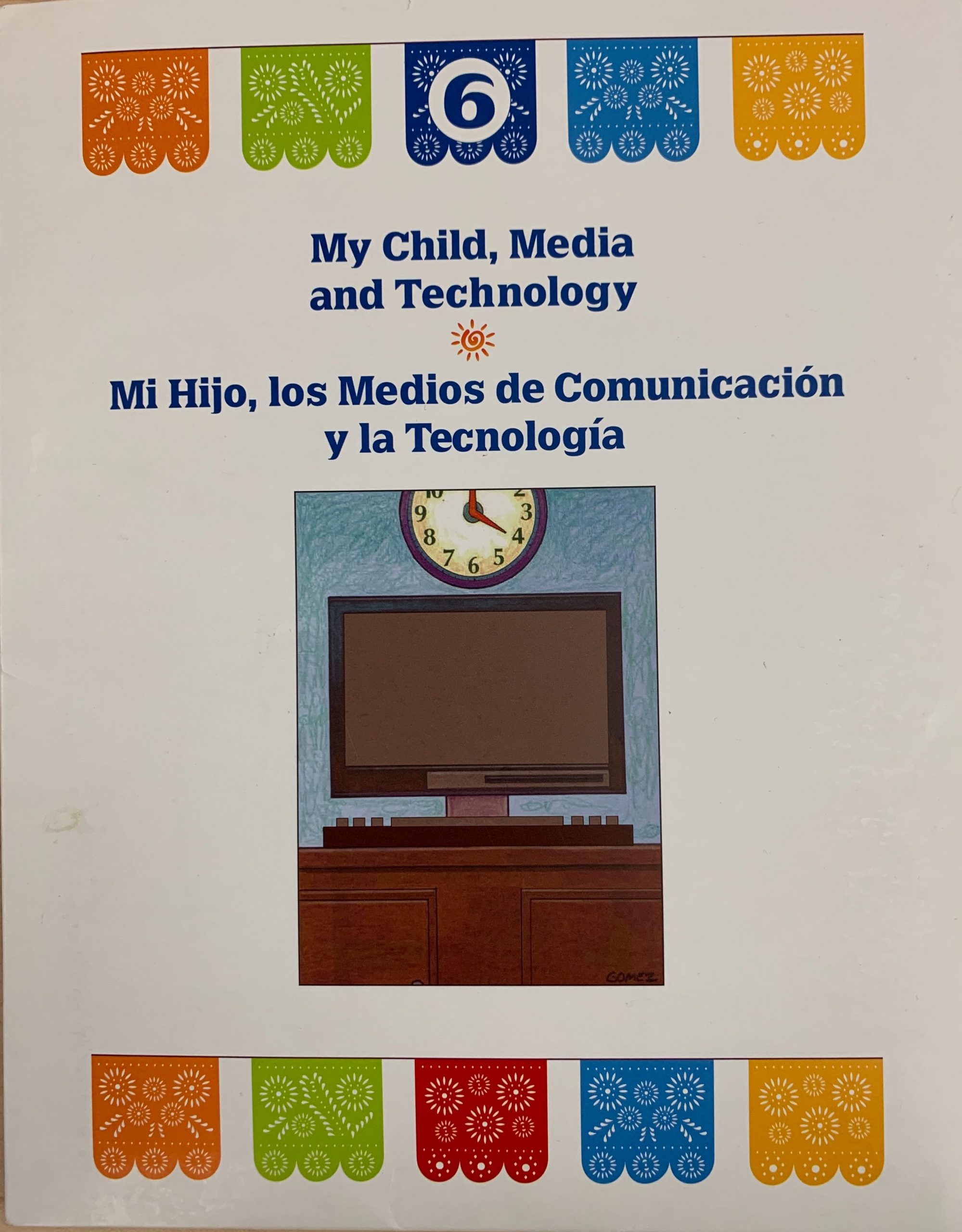 Our new report, Digital Media and Latino Families, takes stock of recent research that reveals widening use of digital media by Latino children, along with the multifaceted effects on their learning and their families. We find, empirically speaking, that the much discussed “digital divide” no longer hampers Latino families, as parents continue to buy mobile devices and computers shared with their children. But we also found that Latino parents report their children use electronic tools less often for school work or educational tasks, compared with middle-class (non-Latino) White peers. Is the divide of access becoming a different kind of divide, in which participation and usage become key factors to explore?
Our new report, Digital Media and Latino Families, takes stock of recent research that reveals widening use of digital media by Latino children, along with the multifaceted effects on their learning and their families. We find, empirically speaking, that the much discussed “digital divide” no longer hampers Latino families, as parents continue to buy mobile devices and computers shared with their children. But we also found that Latino parents report their children use electronic tools less often for school work or educational tasks, compared with middle-class (non-Latino) White peers. Is the divide of access becoming a different kind of divide, in which participation and usage become key factors to explore?
Recent national surveys find that 49% of Latino adults now own a smart phone, while nine in 10 own a cell phone of any kind, statistically equal to the proportions for White adults. The share of Latino adults reporting regular use of any online device climbed from 64% to 78% between 2009 and 2012, nine points behind White adults. These shares range higher among Latinos raising children, especially in English-speaking households.
We also detail the blizzard of digital content now aimed at Latino children, some designed for Spanish speakers. But the growing range of programs and apps penetrating into Latino communities rarely allow parents to teach their children about cultural heritage, social values and assets, or forms of social cooperation emphasized by many Latino parents.
The narrowing of basic access to mobile devices and the Internet, enjoyed by Latino adults and children of late, stem largely from interviews with nationally representative samples of Latinos with young children conducted by Northwestern University or the Pew Research Center. Anthropological work is beginning to reveal the ways in which children and parents increasingly wield digital tools either in isolation or learning and playing together.
Persisting Inequities, Uneven Learning Effects
Two digital disparities persist for Latino children, especially those raised in households with low incomes or headed by foreign-born parents. Fully three-fourths (77%) of Latino parents with annual household incomes over $50,000 now own a smart phone, compared with just two-fifths (40%) of Latino parents earning under $30,000 yearly. Similarly, 69% of parents in Spanish-dominant households owned a laptop or personal computer in 4, relative to 82% in English-speaking Latino households.
Heavier reliance on electronic media for entertainment among Latino children, not for educational purposes, manifests a second disparity relative to White peers. This applies to television viewing, not only the use of contemporary digital devices. Latino children use electronic devices (excluding TV) almost 90 minutes each day on average, when including smart phones, tablets, and personal computers, compared with just under 60 minutes of daily use among White peers. Latino children also watch two hours of television per day on average, one half-hour more than their White counterparts.
The type of mobile device purchased may condition the extent to which children engage educational contents. Almost one-half (46%) of White parents with a child under 8 years-old now own a tablet or e-reader, compared with 29% of their Latino peers. Such disparities in the sophistication of the mobile devices selected by parents appear among income groups with ethnic populations as well. Still, little is known about how these digital tools are shared with children for educational or entertainment purposes.
Many parents–independent of ethnic background– share digital devices to occupy their young children or tap into games, cartoons, and movies. Initial national evidence shows that such entertainment goals often dominate in Latino households, where educational applications remain less frequent, compared with households headed by White parents. This starts with how parents use digital tools. Latino adults are significantly more likely to play games, access social-networking sites, and send photos on their smartphones than White peers, according to one national survey.
Just under half (45%) of Latino parents with children under 8 years-old report enforcing no rules for time spent on the Internet. The five most frequent activities in which young Latino children are engaged ‘often’ or ‘sometimes’ include playing games (65%), listening to music (49%), doing school homework (47%), watching YouTube or video clips (46%), and watching TV shows online (39%). This emphasis on entertain is correlated with maternal education levels, which tends to disadvantage a higher share of young Latino children than White peers. Low-income Latino parents expect stronger learning benefits digital tools, such as advancing their child’s reading or mathematical skills, relative to less sanguine expectations of middle-class Latino parents.
Thin Evidence on Learning Benefits
After searching the empirical literature we found few studies that examine even short-term learning effects stemming from this rising use of digital media by Latino children. Old-fashion learning theory – focusing on the individual child’s cognitive stimulation and processing – constrains how we conceive of learning and socialization in differing cultural contexts. The incidental effects of entertainment or social networking on novel behaviors or values, likely taken up by Latino children and youths, remain unexplored.
We do know that Latino youngsters, proficient in English, broker many public transactions for their parents and older kin members. Local studies now detail how digital media play a huge role in selecting child care or schools, locating health clinics or social services – often facilitated by children tapping digital tools. But evidence remains thin on whether their rising use of new media advances learning for Latino children or buoys their performance in school.
Overall, an unsettling irony emerges from our review. We know that digital tools increasingly shape the daily activities, social values, and daily upbringing of Latino children from toddlerhood forward. Yet we know little about the benefits and risks of online activities, games, and networking platforms. We have little evidence on the possible cognitive growth or novel social norms experienced by Latino youngsters. Nor do we understand how the child’s or teen’s relations with parents may be altered.
A Blizzard of Apps Aimed at Children
We also review the widening flurry of programs and digital apps that aim to capture the attention of children and families. What Latino children are learning is largely driven by the content that’s shaped by for-profit firms. Only a fraction of available programs aim to boost the learning for young Latino children; even fewer computer games or apps build from the language and socialization priorities of (diverse) Latino families. An increasing number of apps do offer versions in Spanish. But, more deeply, these applications rarely allow parents to teach their children about cultural heritage, social values and assets, or forms of social cooperation emphasized by many Latino families.
The report accents the rise of curation services offered by private and nonprofit firms that assess the breathtaking variety of games, educational programs, movies, and apps now aimed at pre-k and school-age children. We detail the weaknesses and lack of transparency of the ratings offered by major firms, which allege that they gauge educational content and benefits.
A handful of nonprofit organizations now offer more discerning curation services, at times taking into account the quality of content and developmental fit with the child’s age. Still, curators to date show little capacity to inform Latino or non-mainstream parents about the cultural relevance of digital offerings, even to carefully advance bilingual skills.
Do Digital Tools Recast Parental Authority?
The advent of television, going back to the 1950s, reshaped daily activities inside the home for children and parents alike. The rising use of digital tools similarly expands the amount of time in which children labor alone or with peers—playing games, watching new channels of entertainment, networking with friends, even occasionally pursuing educational topics.
One question on the scientific frontier: How do these new media further separate children from daily interactions with parents, and do the novel social norms and information delivered undercut traditional forms of parental authority commonly seen in Latino households? Beyond the growing evidence on how Latino children broker interactions for older kin, we know little about the effects of digital tools on social relations inside families.
Our report sketches what’s known about the pro-family values and stiff yet supportive discipline often practiced by Latino parents. How digital tools advance the learning of Latino children, while shifting parenting authority and social norms inside families, remains an intriguing question about which researchers know little.
This analysis was sponsored by New Journalism on Latino Children, an undertaking of the Education Writers Association, Latino Policy Forum of Chicago, and the University of California, Berkeley. Special thanks go to Diana Hess at the Spencer Foundation and Sara Slaughter, McCormick Foundation, for their generous support.
Bruce Fuller, José Lizárraga, James H. Gray
University of California, Berkeley


